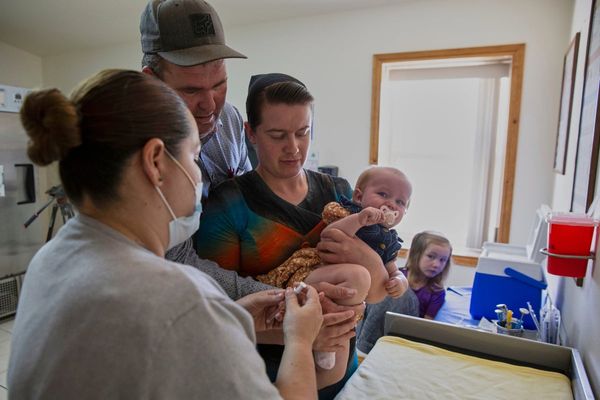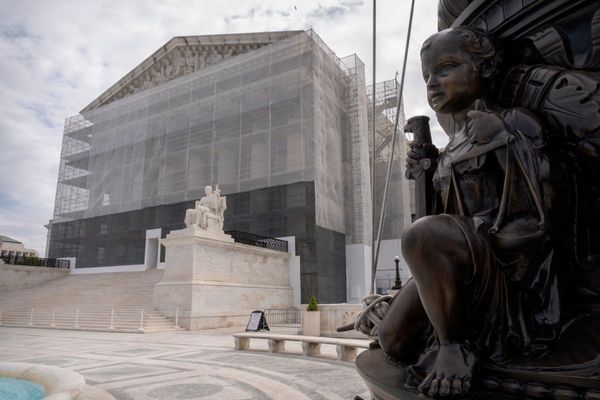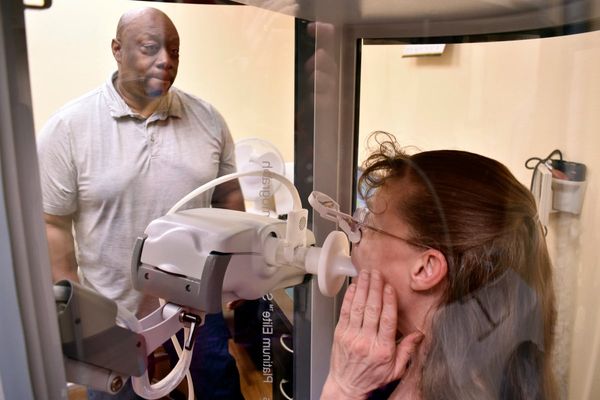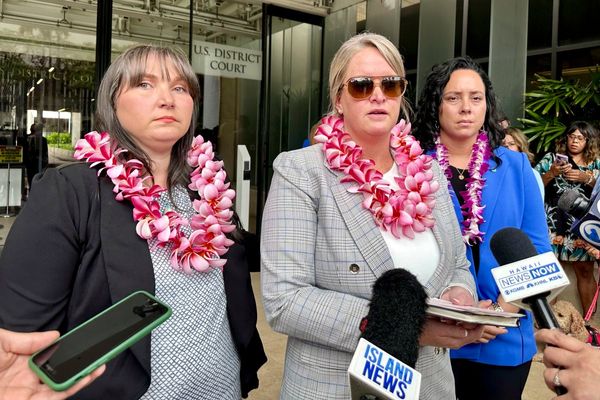
Back in another time, in June 2018, when wages were barely moving and inflation was low, Reserve Bank governor Philip Lowe mused in a speech that wage stagnation was eroding the nation’s “sense of shared prosperity” and made much-needed productivity-enhancing economic reforms “more difficult” to achieve.
He said the central bank expected wages growth to gather pace as unemployment fell. Unemployment did; wages didn’t. He nostalgically wished for a world where wage increases start with a three rather than a two: “This is not a call for a sudden jump in wages growth from current rates to three-point something. Rather, we will be better off if this increase takes place steadily over time as the economy improves.”
Now wages are rising with a three but inflation is nearly an eight, so real wage growth has collapsed. The Reserve Bank’s nine rate rises since May 2022 are seen as the culprit, along with the prediction from Lowe and the bank back in 2021 that interest rates would remain low until 2024 (at the 0.10% level that existed at the time).
A week ago, Lowe told Senate estimates that the central bank is not observing a wage-price spiral — in which wage increases cause price increases which in turn cause wage increases — despite excitable claims to the contrary from politicians of a conservative bent, business commentators, economists, brokers and business people moaning into the ears of compliant media.
Yesterday we got confirmation of the accuracy of Lowe’s comments in the December quarter and 2022 wage price index (WPI) data from the Australian Bureau of Statistics (ABS), which revealed a slowing in the quarterly rate of growth but a pick-up in annual growth to the highest rate in nearly 11 years.
The ABS data showed the annual rate of wages growth in the index rose to 3.3%, up from September’s upwardly revised 3.2% (3.1% originally), meaning employees in private and public organisations suffered their largest ever fall in real wages of 4.5% over 2022. In fact, the WPI at 3.3% was less than the Reserve Bank’s latest forecast earlier this month of a 3.5% rise for 2022.
So we have wages growing at the fastest rate in 11 years in nominal terms, but growth collapsing at the fastest rate recorded by the ABS thanks to inflation at 7.8% in 2022 (and 8.4% in December, according to the monthly inflation indicator).
As Lowe told the Senate lightweights, there’s no wage-price spiral in sight and wages growth is actually weaker than the bank thinks it will be at more than 4%. (That’s no surprise given how the bank has consistently been too optimistic about wages growth even as it stagnated before the pandemic.)
So what did our mainstream media think of the story? Well, the ABC played up the collapse in real wages, as did The Sydney Morning Herald — on its website. In the published newspapers on Thursday morning, the story was buried by The Sydney Morning Herald, The Australian Financial Review and The Australian.
You can bet that if the WPI had risen to well over 1% in the quarter, all three would have carried alarmist, nonsensical stories on the wage-price spiral and no doubt another ignorant editorial on the matter from the AFR.
But then News Corp and Nine are part of the problem. Both companies have lifted the prices of their papers by more than the near-8% inflation rate in the past year. The AFR’s 50 cents (to $4.50 a copy) was a bit rich, but so is The Weekend Australian now at $7 a copy.
In searching for reasons why inflation is becoming “embedded” in the wider economy (even as world prices for energy in the shape of coal, LNG, petrol and oil crash to levels from before the Ukraine invasion a year ago), the price rises by the two media companies are good examples of why business in this country is ripping people off.
The Albanese government and the RBA are failing to call this out. (Only former ACCC head Rod Sims and commentators like Fairfax’s Ross Gittins have had the courage to go down this route.)
This rip-off is being illustrated every day in the current December reporting period for ASX-listed companies. Take the Commonwealth Bank (CBA): its shares have been sold off since it reported record interim earnings, dividends and a boost to its buyback. Just look at the numbers. Thanks to eight of the RBA’s nine rate rises, the CBA’s net interest margin surged by 22 basis points to 2.1% (a 12% rise) compared with the six months to December 2021, and 18 (0.18%) points compared with June 30 2022. Costs in the half were up just 5%, which is also a lot less than inflation and a lot less than the 12% rise in operating income.
CBA shareholders will receive an interim dividend of $2.10, an increase of 35 cents, or 20%. That’s higher than the pre-COVID peak for an interim dividend. And all those gains are well above the rate of inflation while costs were considerably less than inflation. One billion dollars was added to the buyback because the bank had too much capital — earned from higher rates and charges than need be.
Look also at the profit reports from major supermarkets Coles and Woolies this week. Coles boosted profit by 17.1% on a 3.9% rise in sales for the half year, and its profit margin rose to 3% from 2.6% — a rise of 15% and lifted dividend by 9% to 36 cents. Woolies’ half-year profit rose 25% on a 4% rise in sales and boosted dividend by 18%.
All those rises were faster than inflation and these retailers were among the most vociferous of companies warning of the dangers of inflation.
Ampol reported record earnings and profit and paid a 50-cents-a-share special dividend, as well as a “normal” ordinary final dividend of $1.05 as it rose petrol and oil prices higher across 2022. (Thanks, Vlad.) It wasn’t alone: Santos, the noisiest of energy companies, saw its underlying profits treble to US$2.46 billion for all of 2022 and a final dividend of 15.1 cents a share, up nearly 80%.
These rises in profits and dividends underline how these companies are getting away with embedding cost and price increases into the pay packets of most Australians, as well as tens of thousands of small businesses who find it hard to pass on their higher costs.
It also raises the question of why the Albanese government, for all its talk of equity, didn’t follow the likes of India and impose a temporary windfall profits tax on energy companies (it is now reducing the tax as energy prices fall) and then use the tax gains to help at-risk consumers and small businesses?
The problem with our current inflation/cost-of-living story is that the criticism of the RBA and its guidance mistakes on interest rates ignores the other culprits: the business-dominated RBA board that decides on rates; the hesitant government in Canberra and Treasurer Jim Chalmers (who is starting to sound more like Peter Costello than Paul Keating); and partisan analysts and economists who can only see inflation rates and not the causes at the broadest level.
Because wages costs are the single largest input, the focus is continually on them, which at the moment is allowing rapacious businesses and shareholders (all of us through our super) to transfer tens of billions of dollars from workers and their falling real wages to the profit and loss and dividend lines of these big companies — which face little competition.
And on the way, the media, the analysts, the economists, the fund managers, the accountants, the banks, the PR merchants and all the other coupon clippers — they each grab their share and leave the bulk of Australians poorer.







